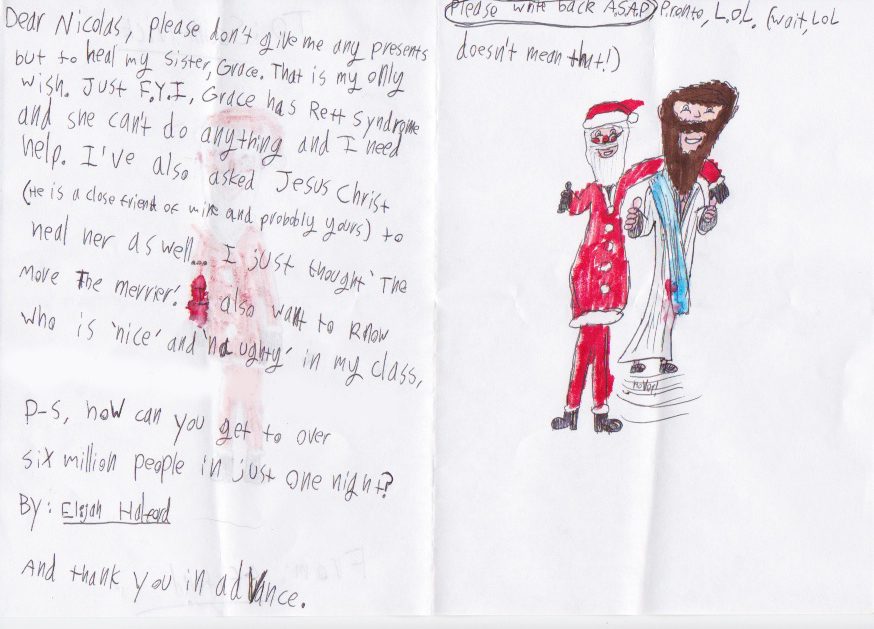“After a few days we took her home and tried to carry on life as normal. Everyone asking me how she’s doing, thinking it would all be over soon.”
I stumbled upon this post from a few years ago. Steven had posted it on his blog, but I guess it never made it over here on this one. And what a relief because I don’t think that I can remember ever sitting and writing our diagnosis story, although it’s a story that we need to tell.
Written November 8, 2010
Most of you out there who might read this blog know I have a daughter called Grace Catherine May Halford. She’ll be 2 years old this month.
I have never written anything about her before, or my life with her, I usually leave that for my wife. My wife blogs about her and keeps my family and friends up to date with how she/we’re doing.
When my daughter was rushed to the hospital last October 2009 it was sheer panic for my wife and I. We have 3 children, all under 7, and going to the hospital is no fun, especially when you think your daughter is about to die.
It started last year (2009) about October time. My daughter had never learnt to sit up and have never spoken, we put it down to her just being a lazy baby. Grace was born a normal girl, with lots of thick, dark hair. She had an olive complexion like her oldest brother, like my mother and like my wife’s family. She was growing fine, had great eye contact, laughed a lot, never cried much, and fed herself food.
When she was almost 1 years old I went to Nigeria for 2 weeks to teach and preach. It was a great trip, although a little nerve racking. I couldn’t wait to get home to my wife and children. One thing I remember from back then was how much I looked forward to growing with my daughter, to seeing her laugh, and run, and dance. I would look forward to her wedding day where one day I would give her away to a man I knew would be THE one! She was already a Daddy’s girl and I would look at her for what seemed like hours on end. We just stared at each other, often laughing, and making each other laugh. The way I looked at her and she looked at me made me think of the way our Heavenly Father looks at us, with such love and joy. Nothing could break our gaze.
Then I returned from Nigeria. I got home and woke my children up as it was late at night and I kissed them and gave them gifts. Then I went in to see Grace. I didn’t say anything but I knew something was wrong. She wasn’t her usual self, I just put it down to tiredness or maybe my mind was playing tricks on me due to the long flight.
Then the next morning I saw her and immediately knew something was wrong. Her lovely deep gaze was withdrawn, she was shaking a little bit and was even worse at sitting up. She was so floppy I didn’t know how to hold her. When sitting in her high chair she couldn’t put food in her mouth anymore and was looking at her hands as if she was seeing them for the first time. I was so hoping it was just a cold. We watched her get worse over a couple of days then decided to call the doctor. The reason we waited so long was we thought she was just taking her merry time to reach her milestones. I don’t know, maybe we were lying to ourselves, hoping everything would turn out okay.
The doctor saw us that week and immediately referred Grace to the Paediatrician. This would take up to 6 weeks though (gotta love the NHS!). We waited as long as we could, just hoping and praying everything would be alright. We kept this to ourselves as we didn’t want to worry anyone, and I think we were in denial that anything could seriously be wrong with my beautiful daughter.
About one week after the doctor’s appointment, after we had sat there and tried feeding her Cheerios and other foods (to no avail) she started crossing her eyes. And I don’t mean the cute way a baby does, I mean all the way in. It went on for about 3 days, and got worse and worse and lasted longer and longer. Then my wife met with some girls from Church and they prayed, then my wife told them about her eyes. Some of the ladies there felt she needed urgent care. That was all we needed to know to rush Grace to the hospital!
We arrived in the emergency room and we didn’t have to wait. They took her right through and did some basic tests. Whilst in the first waiting room bed there was a boy who had sliced his foot and was getting his flesh sown back together. I must say, a good distraction 
Then they took her to a bed and kept her there for 2 days. She had test after test. We knew the doctors knew what was wrong with her as they weren’t too worried about her dying. I thought my daughter was going to die, and I saw her life just ebbing away. I was losing my Gracie, and my heart was breaking. Not only was I losing a daughter, but my boys were losing their sister and Elizabeth (my wife) was losing her too.
She had loads of blood tests and a brain test, to see if she was having seizures.
Although it was heartbreaking, we had peace. The Church rallied together and prayed day and night for us, they cooked dinner for me and the boys. They took care of the boys whilst we were at the hospital. They did everything. I have to be honest though. I was sad to see my natural family do nothing. My adopted family were there all the way but I kept looking for rays of hope from my birth family. Unfortunately many people don’t know how to handle tragedy. They just hope it goes away, or hope it doesn’t infringe too close to their territory which has taken a life time to build. Christians are vulnerable people. We put ourselves out there, our lives on the line for others. We weep with people, we rejoice with people, we hurt with people. And I had so many people there to hurt with us, as well as knowing Jesus was there going through this with us.
In a few short days it felt like my world was crashing down. The love I have for my daughter is love I have for no one else. I love my wife with a deep, intimate love. I love my sons with a deep, unquenchable love, and I love Grace with a deep you’ll always be my little girl type love (no matter how big you’ll get). I never thought I could be so in love with my children, but I am! 
The hardest part was to no longer have her gaze into my eyes. It was crushing.
After a few days we took her home and tried to carry on life as normal. Everyone asking me how she’s doing, thinking it would all be over soon. We found out she (probably) won’t be dying anytime soon, but still no prognosis. They said we hope to know in about a month. We searched the internet looking for what she may have. Then one day per chance Elizabeth (not my wife), a friend in our Church said “Ooh, she looks like she might have Retts”. Well, we got home and did our research (actually my wife did). She called me and said I must look on Youtube and look at Rett Syndrome kids. I did and all the girls on there looked and acted just like Grace. We could barely believe it but we knew this is what she had. It was a relief to know what we were now up against.
We went to the doctors in December 2009 and they couldn’t give us her diagnosis, we had to wait 2 more weeks. We told them we think it’s Retts and the room went silent. Their silence gave it away.
We were all the time hoping that it was nothing more than a bug that affected her brain temporarily. Even up until the day we found out I was optimistic it was nothing too bad, after all, I surely couldn’t have a disabled child, not me!
But that day came, and we heard the news that made my heart sink a mile and my hopes and dreams for my little girl get buried with her little personality. Grace has Rett Syndrome. There is no cure! We will have a severely disabled child for the rest of her life, and no one knows if it will be a short or a reasonably long life. The diagnosis just brought on more questions, but at least we knew what to expect and look for, and pray for in the future.
Since that day we have had our ups and downs. We have shed many tears,and I still do, knowing my little girl is trapped inside this body that won’t cooperate with her mind. My daughter can’t sit up, speak, crawl, walk, feed herself, do anything meaningful with her hands, go to the toilet by herself, and the list goes on. BUT, she can make us laugh, and she herself has so much joy that it’s contagious!
When she first got bad it was said she was at the end her regression stage. This was supposed to have started at about 6 months and finished at about the age of one year. We lost her for a while, but she has come back again, although a somewhat different girl than we first thought she would be.
She sleeps through the night, and laughs when I kiss her. She has a strong affection for me and makes my heart melt every time I think of her. She has a purpose in life. She is loved and all who meet her are loved, unconditionally by her. It is a struggle, but one I happily go through for the love of my life. Our days are filled with medicines, vitamins (she can’t chew food, everything is blended), therapies, keeping her new glasses on, and trying to keep her busy to strengthen her weak body.
I cringe every time I think of any time I ever looked at a disabled child and not smile and love them, or when I judged a parent of that child for not doing more to shut him/her up when they screamed out. My daughter often screams at the highest pitched scream you will ever hear (no exaggeration). It is embarrassing knowing everyone is hating that we are there in this restaurant as all they want is a peaceful lunch, as do we! She looks normal and has a cool looking buggy so people put it down to us not caring.
My wife and I have our struggles. It is hard and frustrating. We wish we had more support from family. Just one night out, or a day away from our children without worrying about them would do the world of good (no, it’s not a pity party, I’m just writing my rare feelings into this blog). But this is the life God has for us, and I gladly wear these chains, that can sometimes be heavy. I fear she will die young, it is on my mind more than it should be, knowing this is a reality……BUT for God!
I have not lost my love for my Creator, but have fallen in love with Him more and more, thanking Him for counting me worthy to be able to take care of such a beautiful girl as Grace. I secretly cry often with my girl, especially when she wakes up in the night screaming in pain due to her heartburn (common with Rett babies). I ask God to heal her, but so far He has not answered the answer I want from Him. I’m not angry at God though, and haven’t even asked Him why. God doesn’t make mistakes, and I thank Him that He chose us!
I put on a brave face in public, but inwardly I’m hurting, knowing that no one knows my pain for my girl.
If you’re reading this please know that Jesus loves you, He loves me, He loves Grace. In the midst of pain He will be there, to those who call on His name. Thanks for reading 
Steven.
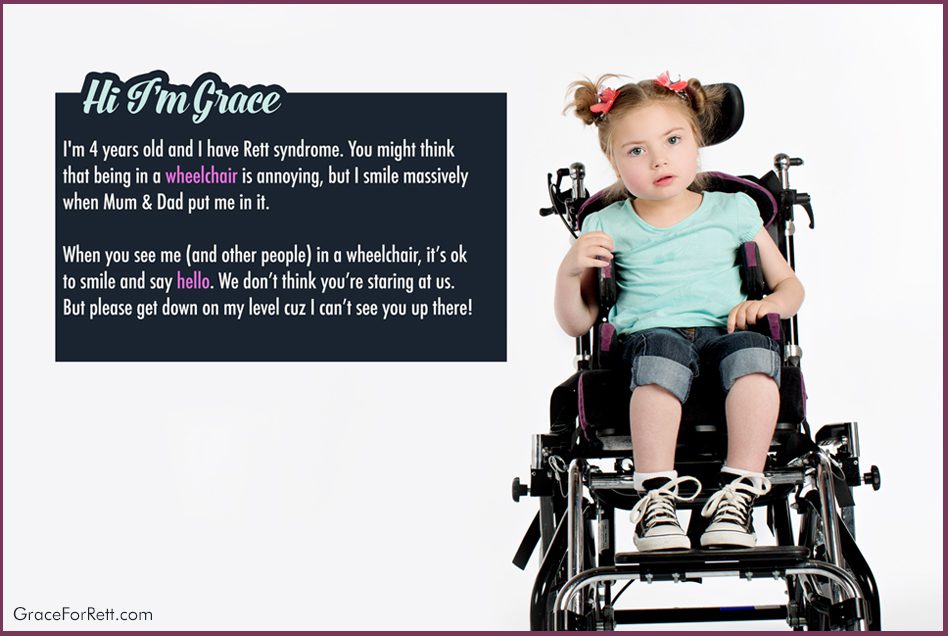 It’s estimated that 50% of girls and women with Rett syndrome can walk. This leaves the other 50% using wheelchairs and other mobility aids like hoists, standing frames and sitting solutions.
It’s estimated that 50% of girls and women with Rett syndrome can walk. This leaves the other 50% using wheelchairs and other mobility aids like hoists, standing frames and sitting solutions.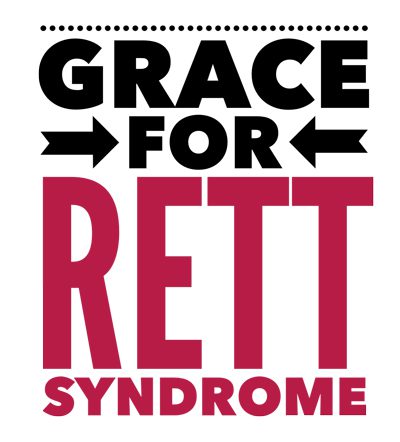




 This is Charlie —> I took this photo at one of the Cure Rett Picture the Hope Awareness Tour photo shoot days. And then just a day or two later, she fractured her femur at school. She wasn’t doing anything spectacularly taxing – just hanging out in the sensory room. She was simply moved and that’s when they believe the fracture happened.
This is Charlie —> I took this photo at one of the Cure Rett Picture the Hope Awareness Tour photo shoot days. And then just a day or two later, she fractured her femur at school. She wasn’t doing anything spectacularly taxing – just hanging out in the sensory room. She was simply moved and that’s when they believe the fracture happened.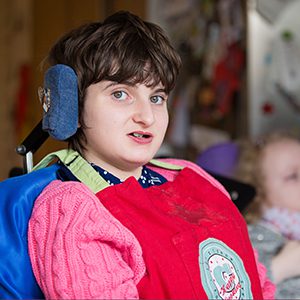


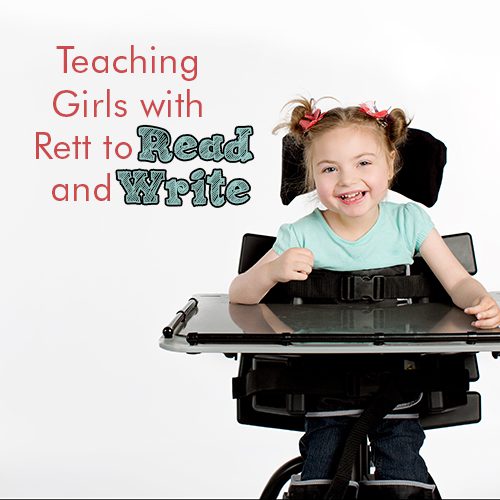 Note: there’s video in this post. If you can’t see it, click
Note: there’s video in this post. If you can’t see it, click 
